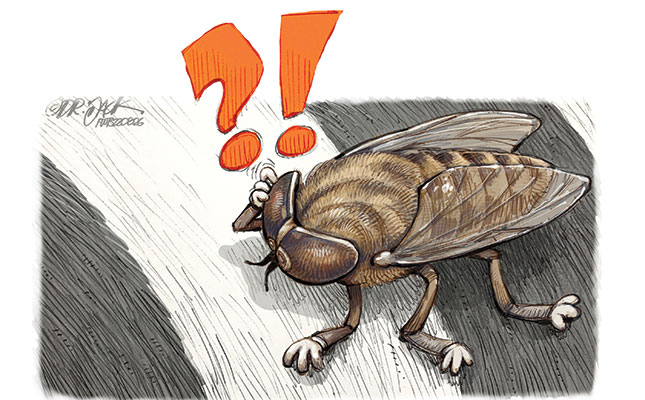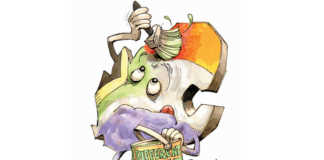
Since the debate between Francis Galton, Alfred Russel Wallace and Charles Darwin between the 1850s and 1870s, many ideas have been proposed for the possible functions of a zebra’s stripes. The main hypotheses are the following:
- Apparent size increase: The stripes could induce a visual illusion, increasing the apparent size of zebras and ensuring an advantage over their predators.
- Decreased visibility in twilight: At dusk and dawn, or in moonlight, stripes might be difficult to discern.
- Dazzling the eyes of predators through motion: The moving stripes of escaping zebras may dazzle and confuse predators, making it difficult for them to select an individual zebra from the herd.
- Optical camouflage from predators: Stripes may dissolve the contours of the animals, enabling them to blend in with their background.
- Intraspecific communication by individual stripe patterns: Zebras may recognise each other by means of their individual stripe patterns, which could be visual markers for group bonding and/ or particular body parts for grooming.
- Warning colouration, or aposematism: The conspicuous striped pattern of zebras may offer protection by advertising antipredator defences, such as dangerous kicks and bites, and thereby warn predators to avoid them.
- Visual defence against bloodsucking, pathogen-carrying tsetse flies and tabanids: Since tsetse flies and tabanids avoid striped targets and prefer homogeneous objects, they do not bite zebras as frequently as solidly coloured host animals.
- Visual signalling of fitness: Irregularities in the stripe pattern because of injuries or other dysfunctions could visually signal the poor physical condition of a zebra to mate-seeking conspecifics.
- Cooling by convective air eddies above sunlit stripes: Sunlit black and white stripes may induce rotary convections, so that air eddies cool the animal.
Field experiments have shown that female horseflies rarely attack host animals with a
coat of inhomogeneous (striped or spotted) intensity and/or reflection-polarisation patterns.
The attractiveness to tabanids quickly decreases with increasing inhomogeneity (increasing number and decreasing width of stripes/spots) of the coat, and below a critical stripe/spot width the target becomes unattractive to horseflies relative to a homogeneous coat. The stripe widths of the three living zebra species (Equus zebra, E. burchelli and E. grevyi) fall below this threshold.
The exact reason for the tabanid-repellency of inhomogeneous coat patterns is unknown. In this work, we propose a new explanation, which does not exclude the validity of the earlier ones.
Zebra-striped patterns do not lose their tabanid-unattractiveness even if tabanid-attractive gases (carbon dioxide and ammonia) are emitted to an extent that is characteristic to the host animals. Thus, the visual tabanid-repellency of zebra stripes overwhelms the attractiveness of zebra-specific odours.
Dark surfaces are warmer in sunshine
In the case of sunlit targets with inhomogeneous patterns, the few attracted female horseflies land mainly on dark stripes/spots rather than of light ones. The main reason for this behaviour is that in sunshine, dark surfaces are warmer than light ones, and tabanids prefer warmer host animals as they can escape from warmer targets more easily to avoid the parasite-repelling reactions of the attacked host.
We propose the following new explanation for this phenomenon: a blood-seeking female horsefly landing on a host animal should find a blood vessel directly below the host’s body surface.
This may be performed by thermoreceptors on her legs, antennae or mouthparts that sense the slightly higher skin temperature above a vessel relative to its surroundings.
Thus, vessel location could happen with thermoreception by means of vessel-induced temperature gradients. Tabanids evidently prefer warm, sunlit host animals and targets.
If the sunlit coat of a host is striped, all borderlines of adjacent dark and bright stripes have temperature gradients (differences), because in sunshine the dark stripes are warmer than the light ones.
The temperature gradients at the borderlines may deceptively imitate vessel-induced temperature differences for a female horsefly seeking blood if she looks for vessels by thermoreception. Thus, the borderlines of sunlit black and white stripes may successful hamper thermal vessel detection.
According to our hypothesis, tabanids generally avoid landing on striped (or spotted) hosts, because on such targets it is difficult to locate vessels by thermoreception due to the disruptive temperature gradients of the numerous borderlines of black and white stripes in sunshine.
Female horseflies wanting to suck blood therefore attack striped host animals less frequently than they do homogeneously coloured ones, because with the latter, the temperature gradients above blood vessels can be detected more easily than on sunlit, striped patterns.
Field experiment
To test this hypothesis, we performed a field experiment with tabanids. We attracted female horseflies to a grey barrel with thin black stripes mimicking a visually attractive host. The horizontal and vertical black stripes on the cylinder thermally imitated the slightly warmer subsurface blood vessels when the studied half of the cylinder was sunlit.
When the cylinder’s half was shady, the temperature of the black stripes was practically the same as that of their grey surroundings.
We measured the time that walking horseflies spent on the grey and black areas of the sunlit or shady cylinder. Our aim was to determine whether tabanids preferred the black stripes only if they were sunlit and thus warmer than their grey surroundings.
If the stripes were preferred to the grey areas only under sunlight, this preference could be explained exclusively by their higher temperature, rather than their darkness and/or higher polarisation. This would corroborate the supposed thermal vessel recognition in horseflies, and support the theory that sunlit stripes hamper tabanids’ thermodetection of host’s vessels.
In our experiment, host-seeking female tabanids landed on the black-striped grey
barrel. Some walked for shorter or longer periods on the barrel’s surface. While walking, they preferred the thin black stripes to the grey rectangles exclusively on the sunlit
half of the cylinder.
This can be explained by the fact that the sunlit black stripes were slightly warmer than their sunlit grey surroundings, while the temperatures of the shady grey rectangles and the shady black stripes were practically the same.
The walking horseflies might have preferred the black stripes due to their darker appearance and/or larger degree of polarisation and/ or higher temperature relative to those of the grey areas.
However, the stripe preference caused by the stripes’ different darkness and polarisation was excluded by the finding that on the shady half of the barrel there was no stripe preference, nor relevant temperature difference between black stripes and their grey surroundings.
The views expressed in our weekly opinion piece do not necessarily reflect those of Farmer’s Weekly.
This is an edited excerpt of a study titled ‘Sunlit zebra stripes may confuse the thermal perception of blood vessels causing the visual unattractiveness of zebras to horseflies’, by P Takács et al, published in the Nature journal called Scientific Report (12, 10871). FW










